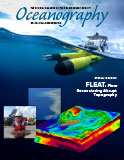Article Abstract
This paper uses the Flow Encountering Abrupt Topography (FLEAT) experiment’s unique data set to examine and document the biophysical environment of an unusual low-light reef habitat in the western tropical Pacific Ocean. Located 1.6 km seaward of the eastern coast of Palau, Ngaraard Pinnacle (NP) rises from the deep ocean to 92 m depth, constituting an “island” where such a habitat exists. Low-light reef habitats have not been well studied and are different from those of typical shallow reef systems. Water temperatures recorded at NP using bottom-mounted temperature loggers vary on two timescales, from hours to days and over months, related to the El Niño-Southern Oscillation (ENSO). This environment is subject to tremendous temperature variability; from 2010 to 2019 temperatures were below or near the lower limits of life for photophilic reefs for months. Mean temperatures shifted 10°–12°C in six months, with low values associated with El Niño and high values with La Niña. The ENSO-related temperatures at NP were similar to those recorded at stations along the main reef, making it among the most variable environments observed in the tropical western Pacific. The stratified water column above NP was subject to sheared currents moving in opposite directions. In this variable physical environment, the biological community is characterized by a modest number of reef invertebrates, very low algal cover, and a diverse and abundant reef fish community. The biophysical data collected at NP show how this rarely observed environment supports the observed community.

